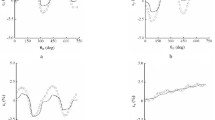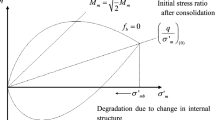The unified hardening model for overconsolidated clay is extended to the cyclic model considering the stress–strain relationship for sands by adopting the rotational hardening rule. The equations for the normal consolidated line and critical state line are revised in the e – ln p space to describe the breakage behavior of gravel sands under high pressures. The power function is used to define the above equations. The model features the following characteristics: (1) equations for the above lines are redefined in the e – ln p space; (2) potential strength is revised by the Hvorslev line containing the power parameter; (3) cyclic behavior of sands is described by the evolutionary rule of current yield surface and rotational hardening rule; (4) generalized cyclic model is realized using the transformed stress method based on the spatially mobilized plane criterion. Simulation results show that the breakage and cyclic loading behavior of gravel sands are adequately described.







Similar content being viewed by others
References
R. Verdugo and K. Ishihara, “The steady state of sandy soils,” Soils Found., 36, No. 4, 81–91 (1996).
J. A. Yamamuro and P. V. Lade, “Drained sand behavior in axisymmetric tests at high pressures,” J. Geotech. Eng.-ASCE, 122, No. 2, 109–119 (1996).
D. Wood, Soil Behaviour and Critical State Soil Mechanics, Cambridge University Press, Cambridge (1991), DOI: https://doi.org/10.1017/CBO9781139878272.
K. Hashiguchi, “On the linear relations of V–lnp and lnV–lnp for isotropic consolidation of soils,” Int. J. Numer. Anal. Met., 19, No. 10, 367–376 (1995).
T. Nakai, “An isotropic hardening elastoplastic model considering the stress path dependency in threedimensional stresses,” Soils Found., 29, No. 1, 119–139 (1989).
G. Gudehus, “A comprehensive constitutive equation for granular materials,” Soils Found., 36, No. 1, 1–12 (1996).
K. Ishihara and S. Yasuda, “Sand liquefaction due to irregular excitation,” Soils Found., 12, No. 4, 65–77 (1972).
J. M. Zhang, Y. Shamoto, and K. Tokimatsu, “Moving critical and phase transformation stress state lines of saturated sand during undrained cyclic shear,” Soils Found., 37, No. 2, 1–59 (1997).
X. S. Li and Y. Wang, “Linear representation of steady-state line for sand,” J. Geotech. Geoenviron., 124, No. 12, 1215–1217 (1998).
Y. P. Yao, D. C. Lu, A. N. Zhou, and B. Zou, “Generalized non-linear strength theory and transformed stress space,” Sci. China Ser. E-Technol. Sci., 47, No. 6, 691–709 (2004).
D. A. Sun, W. X. Huang, D. C. Sheng, and H. Yamamoto, “An elastoplastic model for granular materials exhibiting particle crushing,” Key Eng. Mat., 341, 1273–1278 (2007).
A. S. Saada, P. Puccini, and G. Bianchini, “Information package,” in: A. S. Saada and G. Bianchini (Eds.), Constitutive Equations for Granular Non-Cohesive Soils, Balkema, Rotterdam (1989), pp. 81–88.
K. Ishihara, F. Tatsuoka, and S. Yasuda, “Undrained deformation and liquefaction of sand under cyclic stresses,” Soils Found., 15, No. 1, 29–44 (1975).
T. B. S. Pradhan, F. Tatsouka, and Y. Sato, “Experimental stress–dilatancy relations of sand subjected to cyclic loading,” Soils Found., 29, No. 1, 45–64 (1989).
Acknowledgments
This study was supported by the National Natural Science Foundation of China for young scholars (Grant No. 11402260).
Author information
Authors and Affiliations
Corresponding author
Additional information
Translated from Problemy Prochnosti, No. 5, pp. 98 – 106, September – October, 2018.
Rights and permissions
About this article
Cite this article
Wan, Z., Song, C.C. & Gao, W.S. Elastoplastic Model of Sand Under Complex Loading. Strength Mater 50, 772–780 (2018). https://doi.org/10.1007/s11223-018-0022-6
Received:
Published:
Issue Date:
DOI: https://doi.org/10.1007/s11223-018-0022-6




